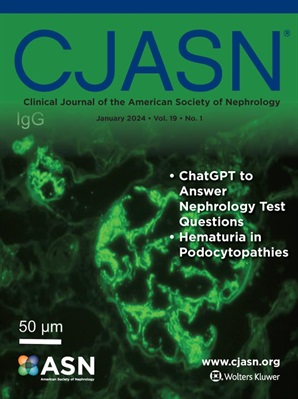儿童和成人IgA肾病/血管炎患者的蛋白尿轨迹和疾病进展
IF 8.5
1区 医学
Q1 UROLOGY & NEPHROLOGY
Clinical Journal of the American Society of Nephrology
Pub Date : 2025-04-10
DOI:10.2215/cjn.0000000707
引用次数: 0
摘要
背景:确定有疾病进展风险的IgA肾病患者对于临床决策、基于风险的患者咨询和临床试验的最佳入组至关重要。方法将IgA肾病(IgAN)和IgA血管炎合并肾炎(IgAVN)患者纳入一项多中心观察队列研究CureGN。儿童和成人分别分为四组进行分析:1)完整组,2)偶发组,3)流行组,4)组织学组。使用两年内蛋白尿测量的潜在类别轨迹模型来定义组。线性混合模型用于计算预测估计肾小球滤过率(eGFR)斜率。在成人中,Cox比例风险模型用于模拟肾功能衰竭或eGFR下降40%的时间作为蛋白尿轨迹组的函数。结果在919名IgAN/IgAVN患者中,368名成人和234名儿童被纳入CureGN。在整个成人队列中,第1组的蛋白尿水平最低(IQR为0.1-0.4 g/g),而第2组和第3组的蛋白尿水平分别为0.5-1.5和1.8-4.1 g/g)。在成人和儿童队列中,平均预测eGFR低于15 ml/min/1.73 m2的时间分别为90年、16年和8年,蛋白尿轨迹组1、2和3的平均预测时间分别为90年、67年和11年。在成人中,调整年龄、入组时的eGFR、免疫抑制暴露和高血压,在完全组、流行组和组织学组中,第3组进展为复合结局的风险分别是第2组的3.13倍(95% CI 1.84-5.33)、1.98倍(95% CI 0.97-4.06)和3.36倍(95% CI 1.59-7.13),但与事件组的进展无关。结论蛋白尿轨迹是IgA肾病患者疾病进展的主要预测因素。本文章由计算机程序翻译,如有差异,请以英文原文为准。
Proteinuria Trajectory and Disease Progression in Children and Adults with IgA Nephropathy/Vasculitis.
BACKGROUND
Identifying patients with IgA Nephropathy at risk for disease progression is critical for clinical decision making, risk-based patient counseling, and optimal enrollment of clinical trials.
METHODS
Patients with IgA Nephropathy (IgAN) and IgA Vasculitis with Nephritis (IgAVN) were enrolled in CureGN, a multi-center observational cohort study. Children and adults were analyzed separately in four cohorts 1) full, 2) incident, 3) prevalent, and 4) histology. Groups were defined using latent class trajectory modeling using proteinuria measurements over two years. Linear mixed models were used to calculate predicted estimated glomerular filtration rate (eGFR) slope. In adults, Cox proportional hazard models were used to model time to kidney failure or 40% eGFR decline as a function of proteinuria trajectory group.
RESULTS
Of 919 individuals with IgAN/IgAVN enrolled into CureGN, 368 adults and 234 children were included in the analysis. In the full adult cohort, Group 1 had the lowest levels of proteinuria (IQR 0.1-0.4 g/g), while Groups 2 and 3 had intermediate and higher levels of proteinuria (IQR 0.5-1.5 and IQR 1.8-4.1 g/g, respectively). Average predicted time to eGFR less than 15 ml/min/1.73 m2 was >90, 16, and 8 years and >90, 67, 11 years for proteinuria trajectory groups 1, 2, and 3, in the full adult and pediatric cohorts, respectively. In adults, adjusting for age, eGFR at enrollment, immunosuppression exposure, and hypertension, Group 3 membership was associated with 3.13 (95% CI 1.84-5.33), 1.98 (95% CI 0.97-4.06), and 3.36 (95% CI 1.59-7.13) times higher hazard of progressing to a composite outcome compared to Group 2 membership in the full, prevalent and histology cohorts, respectively, but not associated with progression in the incident cohort.
CONCLUSIONS
Proteinuria trajectory is a major predictor of disease progression in patients with IgA nephropathy.
求助全文
通过发布文献求助,成功后即可免费获取论文全文。
去求助
来源期刊
CiteScore
12.20
自引率
3.10%
发文量
514
审稿时长
3-6 weeks
期刊介绍:
The Clinical Journal of the American Society of Nephrology strives to establish itself as the foremost authority in communicating and influencing advances in clinical nephrology by (1) swiftly and effectively disseminating pivotal developments in clinical and translational research in nephrology, encompassing innovations in research methods and care delivery; (2) providing context for these advances in relation to future research directions and patient care; and (3) becoming a key voice on issues with potential implications for the clinical practice of nephrology, particularly within the United States. Original manuscript topics cover a range of areas, including Acid/Base and Electrolyte Disorders, Acute Kidney Injury and ICU Nephrology, Chronic Kidney Disease, Clinical Nephrology, Cystic Kidney Disease, Diabetes and the Kidney, Genetics, Geriatric and Palliative Nephrology, Glomerular and Tubulointerstitial Diseases, Hypertension, Maintenance Dialysis, Mineral Metabolism, Nephrolithiasis, and Transplantation.

 求助内容:
求助内容: 应助结果提醒方式:
应助结果提醒方式:


